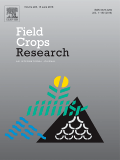Ver ítem
- xmlui.general.dspace_homeCentros Regionales y EEAsCentro Regional Santa FeEEA OliverosArtículos científicosxmlui.ArtifactBrowser.ItemViewer.trail
- Inicio
- Centros Regionales y EEAs
- Centro Regional Santa Fe
- EEA Oliveros
- Artículos científicos
- Ver ítem
Does biological nitrogen fixation modify soybean nitrogen dilution curves?
Resumen
Biological nitrogen fixation (BNF) in soybean [Glycine max (L.) Merr.] represents, on average, 60% of total
nitrogen (N) uptake. Nitrogen dilution curves link aboveground crop N concentration (%N) to biomass accumulation
(W). It has been reported that BNF is an energy-intensive process that might reduce biomass production
per unit of captured N (physiological N use efficiency or NUE). This increased energy cost could lead to a more
attenuated N (i.e.
[ver mas...]
Biological nitrogen fixation (BNF) in soybean [Glycine max (L.) Merr.] represents, on average, 60% of total
nitrogen (N) uptake. Nitrogen dilution curves link aboveground crop N concentration (%N) to biomass accumulation
(W). It has been reported that BNF is an energy-intensive process that might reduce biomass production
per unit of captured N (physiological N use efficiency or NUE). This increased energy cost could lead to a more
attenuated N (i.e. less efficient) dilution curve. However, there are no reports comparing N dilution curves for
soybean crops differing in N source. Our objectives were to: (i) evaluate the impact of BNF on soybean N dilution
curves and how it influences NUE, and (ii) establish independent N dilution curves for soil and atmospheric N.
Our working hypothesis is that relying on BNF attenuates the N dilution curve and reduces NUE. The experiment
consisted of a control and a fertilized treatment, 0 and 600 kg N ha−1 respectively, applied to four soybean
genotypes in order to establish two differential BNF situations. While the control and fertilized treatments had
differential N accumulation from BNF, ∼70% and ∼16%, respectively, there were no differences observed in
seed yield (∼5000 kg ha−1), NUE (∼36 kg kg−1) and only slight differences in total N uptake (∼365 kg N ha−1
in fertilized treatment compared to ∼389 kg h−1 in the control treatment). Results suggest that reliance on BNF
for N does not influence substantially the attenuation of the N dilution curve and has no impact on NUE. The N
dilution parameter (“b”) ranged from −0.128 to −0.218 among cultivars and fertilization treatments. The less
negative values (more attenuated curve) corresponded to the fertilized plots likely associated with luxury N
consumption. Interestingly, dilution curves from soil mineral N showed the typical dilution pattern, while N
derived from the atmosphere followed a concentration pattern as the crop developed. This most likely reflects
the continuous N flux from BNF to the plant as opposed to the decreasing soil mineral N supply. Recognizing
these concentration/dilution curves for atmospheric and soil N has three immediate implications. First, the
atmospheric N concentration curve might indicate an upper benchmark for evaluating symbiosis performance
during crop development. Second, the concentration pattern observed for BNF could potentially help to reverse
the observed decline in seed protein concentration in modern soybean cultivars. Third, the N concentration/
dilution curves for the individual N sources could be incorporated into crop models for estimating BNF at
different crop biomass levels during soybean development.
[Cerrar]

Autor
Santachiara, Gabriel;
Salvagiotti, Fernando;
Gerde, José Arnaldo;
Rotundo, José Luis;
Fuente
Field crops research 223 : 171–178. (2018)
Fecha
2018
ISSN
0378-4290
Formato
pdf
Tipo de documento
artículo
Palabras Claves
Derechos de acceso
Restringido
 Excepto donde se diga explicitamente, este item se publica bajo la siguiente descripción: Creative Commons Attribution-NonCommercial-ShareAlike 2.5 Unported (CC BY-NC-SA 2.5)
Excepto donde se diga explicitamente, este item se publica bajo la siguiente descripción: Creative Commons Attribution-NonCommercial-ShareAlike 2.5 Unported (CC BY-NC-SA 2.5)

